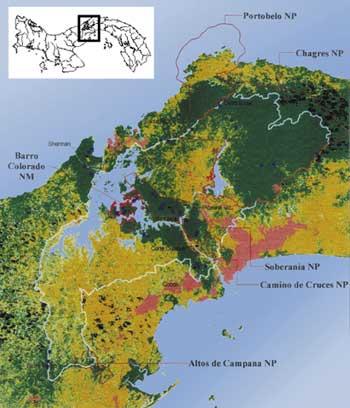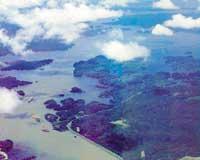The Two Faces of America
Is the Earth round and what? This is of no use if to go from one place to another you have to navigate near the poles. The savings in short journey is lost in the preparation of strong ships. In all cases it is not profitable.
The navigator Magallanes had to travel to the Tierra del Fuego to reach the Pacific; hundreds of other explorers failed in the labyrinth of Canadian channels looking for a northern crossing. On the way from the Atlantic to the Pacific the only alternative was the isthmus of Panama, but it had to overcome 26 meters of height from one coast to another, unsalvable for the ships.

In search of gold
For those who were colonizing the western coast of the United States, believing there was gold in California, the descent to Cape Horn was excessive. It was very dangerous. For example, the road from New York to San Francisco had 21,000 kilometers and had to make a two-month trip. There were many people migrating, so the preparation of a catwalk in Panama became a priority.
The Americans were authorized by the Colombian government and in 1855 a small railway was built. Seven million dollars were spent and 6,000 people died, seeing what came after, but it was cheap.
It is little wonder that there are so many deaths in such a work, in which the rainforest dominated and malaria and yellow fever killed many people.

Work of the French
Panama was not the only problem that could open an important path in the field of communications, since it had a very famous precedent: Suez. It was excavated in 1869 to perform a canal under the direction of the French engineer Ferdinand de Lesseps. Why not do the same in Panama?
There is a big difference between both. That of Suez is the longest of the two, of 120 kilometers, but it is almost plain, with several lakes, so its channel did not need locks and, on the other hand, the formation of lakes allowed to reduce considerably the excavations.
The work in Panama was going to be much harder: the realization of locks was essential and, instead of being lakes, it was necessary to drill the channel of 80 kilometers that crossed the river fourteen times. Despite this, Lesseps' own decided to undertake a work driven by French nationalism.
He began working in 1882. It was a heavy and slow work, interrupted by the rains. In addition, insects, snakes, diseases and the river itself put great obstacles. On the way many workers died. And this unfortunate situation had repercussions in the world. A draftsman of the time, for example, wrote the following question under a cartoon by Lesseps: "What is drilling of Lesseps, channel or tombs?"

Thousands of people realized the origin of tropical diseases, caused by viruses contaminated by mosquitoes and not by withered plants.
Theodore Roosevelt
The work began and was a very strategic geographical point. The president of the United States seemed to him a project of great interest and, once completed and controlled this channel, could control the most prosperous maritime traffic in America. In 1902 he bought the French the right to build the canal.
It was only missing to sign an agreement with Colombia, the channel that was in their lands. But since the Colombian government did not accept the agreement, President Roosevelt helped the independentists of Panama and in 1903 founded the state of Panama, which was defended by the United States army, in exchange for control of the canal. They, among others, drafted the first Constitution of Panama.
The canal was completed with the cleaning of the entire territory, the death with pesticides of all the mosquito colonies of the area, the drainage works and the construction of cities around the bed. Immersed in much of the Chagres River, they founded Gatun Lake and had to excavate 13.7 kilometers of limestone from this lake to the Atlantic. This last section is called the Culebra Court. Finally, the greatest engineering work that had been carried out to date was carried out, but focusing on other aspects: The First World War had begun.
In the year 2000, the Government of the United States gave Panama control of the canal; the decision was made 12 years earlier, when an oil pipeline was built in the west of the state; the presence of the pipeline significantly reduced the traffic of the ship channel.
Sovereignty, the paradox of biodiversity The territory adjacent to the Panama Canal was declared a national park: Parque de Soberania. In origin, the objective of the park was to protect a "sample" of the rainforest, which is currently a territory of 22,104 hectares. Other areas have been protected in Panama, with 29% of the protected territory. Biologists often highlight the biodiversity of the Soberania park. It serves to protect nature and, in passing, also protects the Panama Canal, so it has been politically very interesting. An area created supposedly with an altruistic objective became a security resource. |





